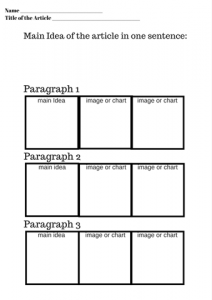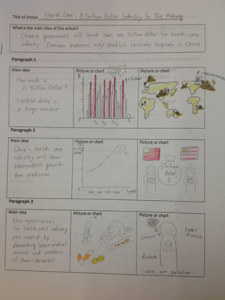by Kia DeKou
When I first started teaching over 20 years ago, the company I worked for was relatively new and didn’t have any resources to share with us. They gave us a binder full of pages (one for each day of the course we were supposed to teach). Each page had a different topic on the top of the page, the rest of the page was blank and we were expected to fill it in with our lesson plans. Any materials that our lessons required were up to us to prepare.
Now this was before laptops and the internet so none of us had brought our computers because they were so big and bulky. We were working with pens, rulers, scissors and glue. Needless to say, those first efforts did not look very professional but it did teach me that even with limited resources, it is possible to create course materials that are engaging and help students reach their goals.
Since then I have created thousands of different kinds of materials for my courses and I get real joy out of designing things that highlight what students can do and help them expand their skills further. Of course, sometimes they flop and I have to go back to the drawing board but that is OK. Failure is where we learn right, so don’t be afraid to use your own materials. Students almost always appreciate teachers who are trying to create courses for them that address their specific needs and creating your own materials certainly shows them that you are trying.
It is also great to get feedback from your students about the effectiveness of your materials. It gives you an opportunity to hone your materials creation skills and it gives them a chance to think critically and express their opinions. You can explain to your students, that just as you evaluate the work they produce for the class, you would like them to evaluate the work you are creating for the class.
Things to Keep in Mind While Preparing Materials for you Class
1. When designing a worksheet, it is important to keep “teacher talking time” in mind. I have seen worksheets that are so full of text there is barely any room left for students to do anything. Just as it is a bad idea to stand up in front of the class and blather on for a half an hour as your students nod off because they have nothing to do, it is a bad idea to fill your worksheets with too many instructions. Such worksheets give students very little to do aside from read, and let’s face it, how many of us love reading detailed instructions?
2. When designing most material for the ESL classroom, don’t forget KISS (keep it simple stupid). ESL students are learning English so try to keep the complicated stuff to a minimum. It is hard enough to be struggling with listening comprehension, grammar structures and unfamiliar vocabulary without throwing in super complicated game rules. It is also a waste of precious class time if you have to spend 15 minutes explaining what they should be doing.
3. It is almost always more effective to show rather than tell. I know that when someone spends too much time telling how to do something my brain starts to shut off or I start to feel stressed out that it is so difficult that I will never get it. If you show me an example of how you want it
If you show me an example of how you want it done however, I have a much better chance of understanding what you want. If you create materials for your activities that show in their design what students are supposed to do with them, just hand out the materials and let them figure it out. If your materials need a bit more explanation, try filling it out yourself to show everyone what to do.
For example, if you are going to give students a graphic organizer like the one below, show them an example of what it should look like.

Different Kinds of Materials You Could Create
In most of my Turkish and Japanese classes, the only materials that teachers brought in for us were worksheets, usually grammar worksheets. While I think grammar certainly has a place in a language classroom, there are so many other kinds of materials you could bring in with you that will make your classes more engaging. The following are just some of the things you could create for your students.
Games There are a myriad of games that are ready made for teachers to grab and use but they won’t be focusing on exactly what you have been studying in your classes or on your unique group of students. I like to make card games using the vocabulary we are learning in class. Usually I used Canva to make cards but even just a simple table on Word works great.
The cards I create can be used for warm up activities (give each student a card, have them think of a question using that word and then do a “mixer” style party in which students have to ask 2 or three other students their question). They can be used to play Memory, Go Fish, Dominoes and many other games.
You could also make board games, puzzles or role-playing games for your students; just make sure that the games are designed around helping your students build and practice the skills that form the foundation of your curriculum.
Songs I am not personally talented at singing or songwriting but I like to bring music into my classroom. One activity I like to do is find songs about the topic we are studying, print out the lyrics for several songs, cut them up, give one line to each student. The students must then find people who have lyrics to the same song and form groups. Then they have try to figure out the order of the lyrics before listening to the song to see if they were correct. When that is finished, they have to perform the lyrics in some way. They could either sing it, act it out, do a dramatic reading or something else they think of.
Reading Passages
Sometimes it is difficult to find just the right passage on just the right subject at the right level for your students so, why not create your own. You could write passages about your own life; I have found that students love finding out more about who we teachers are outside of the classroom. You could write passages using your students’ names, that is always a hit! You could also take an existing passage and modify it to better fit your students’ levels. By sharing your own writing with your students, you are setting an example as a writer and showing them that it is not just something you ask them to do.
Tests
You know exactly what your students have been practicing in your class so you are the best person to create tests for your students. Think about the goals of your class and plan your tests accordingly. If the goal of the class is to pass a multiple-choice test, your test should focus on the skills they will need to achieve that goal. If, on the other hand, your classes focus on essay writing, the test should require them to demonstrate that they know how to write. I have found that so often, a course focuses on one skill while the exam expects students to present their learning using a totally different skill. Try not to do that.
Manipulatives
People love to touch things and move them around. I remember one class I taught in Turkey in which I brought in homemade play dough. I was teaching university students and I can’t remember why I made play dough for them, but I had it all laid out on the table in the front of the class as the students were coming in. The first student looked at it, smiled and asked if she could borrow a chunk of it. I said sure, then the next student came in and did the same thing. Soon all of the dough was gone and the latecomers were begging their classmates for a piece. They just loved holding and shaping it.
I have used play dough to help students play vocabulary games in which students shape the dough to represent words while another classmate guesses the word. I have used it to help students identify the most important idea or scene in a story. They create the scene with play dough, take a picture and illustrate the story.
Photographs
I love photography so I often bring my pictures to class with me. You could also take photographs of your class and bring them in for your students to use as writing or speaking prompts.
Bringing materials that I have made for my classes is great both for me and for my students. I have found that when I create what I give to my students, I have a much clearer idea of why I am giving it to them and how I want them to use it. Quite simply, I have thought about it more and put more of myself into it than when I grab something from a book or from some other source. Creating my own materials also gives me a sense of pride in my teaching. I love seeing my students interact and learn by using something I made just for them.
[wpedon id=23609]





